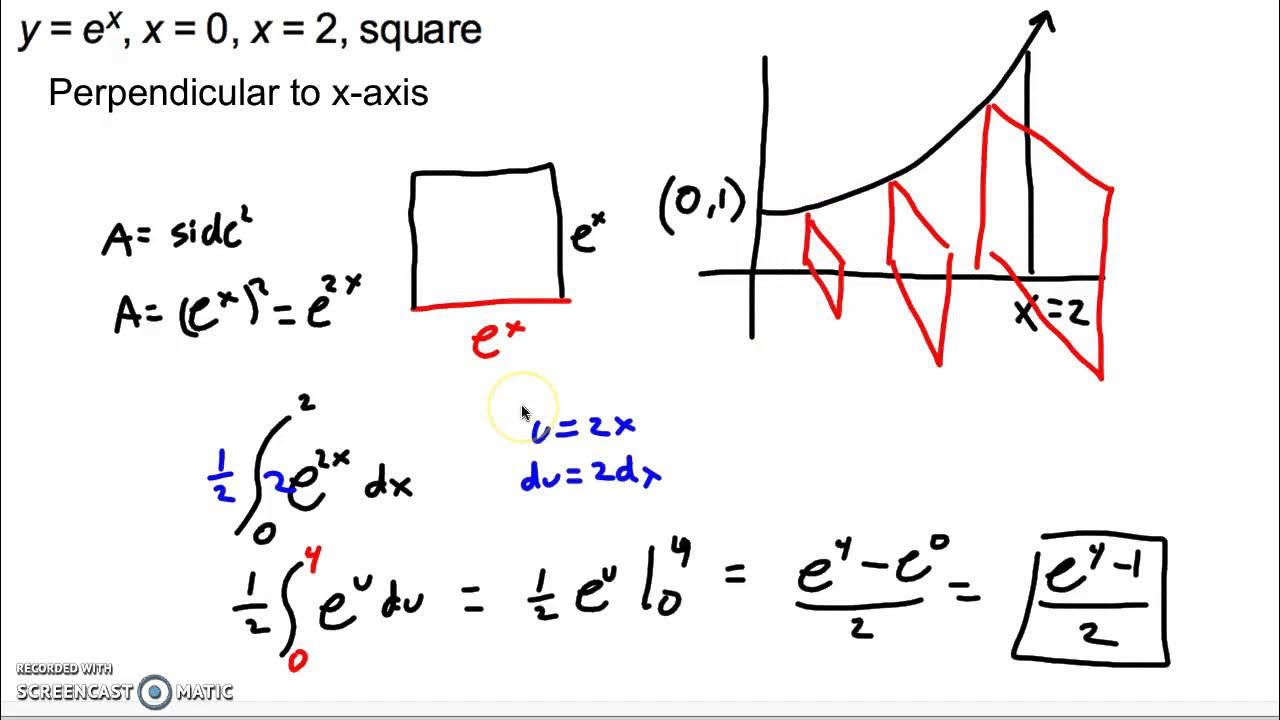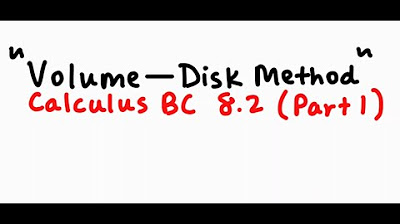Volume The Disc Method
TLDRThis educational video script explores the concept of calculating the volume of solids created by revolving a 2D region around an axis. The instructor demonstrates how to find the volume of a solid by revolving regions bounded by functions and axes, using the method of integrating the square of the radius over the interval of revolution. The script covers various scenarios, including revolving around both horizontal and vertical axes, and introduces the washer method for solids with holes. The parabola y = 9 - x^2 serves as a primary example, with different axes of revolution to illustrate the process.
Takeaways
- 📚 The lesson focuses on finding the volume of solids created by revolving a region around an axis.
- 🔄 The process involves taking a thin slice of the region, spinning it around the axis, and calculating the volume of the resulting shape.
- 📏 The volume of a small disc-shaped slice is calculated using the formula \( \pi r^2 \), where \( r \) is the radius (distance from the axis to the function).
- 🔍 The volume of the entire solid is approximated by summing the volumes of these discs, represented by the integral \( \pi \int_a^b r^2 \, dx \).
- 🔄 For solids revolved around a horizontal axis, the radius is a function of \( x \), and for vertical axes, the radius is a function of \( y \).
- 🕳 When there is a hole in the solid, the washer method is used, subtracting the volume of the inner region from the outer region.
- 📐 The example given involves revolving the region bounded by \( y = 9 - x^2 \) and \( y = 0 \) around the \( x \)-axis to find the volume of the resulting solid.
- 📊 Another example demonstrates revolving the region around the line \( y = -2 \), using the washer method to account for the hole in the middle.
- 📈 The process is also shown for revolving around a vertical axis, with the region bounded by \( y = 9 - x^2 \) and \( y = 0 \), and the axis of revolution being the \( y \)-axis.
- 🔗 The final example involves a region between two graphs, \( 2x - x^2 \) and \( y = x^2 \), and revolving it around the line \( y = 3 \), again using the washer method.
Q & A
What is the main topic discussed in the video script?
-The main topic discussed in the video script is the process of finding the volume of a solid created by revolving a region bounded by a function and an axis of revolution around an axis.
What is the first step in finding the volume of a solid created by revolving a region?
-The first step is to take a thin cross-section of the region, which when revolved around the axis, forms a shape that resembles a disc or a cylinder standing on its side.
What is the formula used to calculate the volume of a single disc formed by revolving a thin cross-section?
-The formula used to calculate the volume of a single disc is Pi times the radius squared (R^2) times the height (h), where the radius is the distance from the axis to the function f(x), and the height is the thickness of the cross-section, Delta x.
How is the approximate volume of the solid obtained?
-The approximate volume of the solid is obtained by summing the volumes of all the thin discs, which is represented by the summation of Pi times R_i squared times Delta x_i, where i ranges from 1 to n, the number of rectangles.
What mathematical concept is used to find the exact volume of the solid?
-The exact volume of the solid is found using the concept of limits, where Delta x approaches zero, resulting in an infinite number of rectangles, which is represented by the integral of Pi times the radius squared with respect to x from A to B.
What is the general formula for finding the volume of a solid of revolution around a horizontal axis?
-The general formula for finding the volume of a solid of revolution around a horizontal axis is Pi times the integral from A to B of the radius squared with respect to x.
What is the difference between the solid formed by revolving around a vertical axis and a horizontal axis?
-When revolving around a vertical axis, the representative rectangles are horizontal, and the radius is in terms of y, resulting in the formula Pi times the integral from C to D of the radius squared with respect to y squared (y^2) dy.
What is the washer method and when is it used?
-The washer method is used when there is a hole in the solid formed by the revolution of a region. It involves subtracting the volume of the hole from the volume of the outer solid, using Pi times the integral of the difference between the squared outer radius and the squared inner radius.
How do you find the radius when revolving around an axis that is not the x or y axis?
-When revolving around an axis that is not the x or y axis, you find the radius by calculating the distance from the furthest graph to the axis of revolution minus the distance from the closest graph to the axis of revolution, using the top function minus the bottom function.
What is the process for finding the volume of a solid formed by revolving a region bounded by two graphs around an axis?
-The process involves finding the points of intersection of the two graphs to determine the range of x values, using the washer method if there is a hole, and integrating the difference between the squared outer radius and the squared inner radius with respect to x from the lower to the upper x value.
Outlines
📚 Introduction to Calculating Volumes of Solids of Revolution
This paragraph introduces the concept of finding the volume of a solid created by revolving a region around an axis. The region is bounded by a function and an axis, and the process involves spinning the region around an axis to form a 3D solid. The explanation begins with a cross-section of the region, represented as a thin slice (Delta X), which when revolved around the x-axis, forms a disc. The volume of each disc is calculated using the formula for the volume of a cylinder (pi * r^2 * h), where r is the radius (distance from the x-axis to the function f(x)) and h is the thickness of the slice (Delta X). The total volume of the solid is approximated by summing the volumes of these discs, which is represented by an integral when Delta X approaches zero. The formula for the volume when revolving around a horizontal axis is given as pi * integral from A to B of (radius squared) dx. The paragraph also discusses the washer method for solids with a hole, using the formula pi * integral from A to B of (outer radius squared - inner radius squared) dx.
📐 Calculating Volumes with Different Axes of Revolution
This paragraph delves deeper into calculating volumes of solids of revolution, focusing on the specifics of different axes of revolution. It starts with revolving the region bounded by the graph of y = 9 - x^2 around the x-axis. The radius is determined by the distance from the graph to the x-axis, and the volume is calculated using the integral formula pi * integral from 0 to 3 of (radius squared) dx. The paragraph then explores revolving the same region around the line y = -2, which introduces a hole in the solid, necessitating the use of the washer method. The outside radius is calculated as 11 - x^2, and the inside radius as 2, with the volume formula adjusted accordingly. The discussion continues with revolving the region around a vertical axis, specifically the y-axis, and the line x = -2, each requiring different calculations for the radius and volume. The paragraph concludes with an example of revolving a region between two graphs (2x - x^2 and y = x^2) around the line y = 3, again using the washer method to account for the hole in the solid.
🔍 Detailed Examples of Volume Calculations with Washers
This paragraph provides detailed examples of calculating volumes of solids of revolution, particularly using the washer method. It starts with an example of revolving the region bounded by the graphs of 2x - x^2 and y = x^2 around the line y = 3. The intersection points of the graphs are found to determine the range of x values (from 0 to 1). The outside radius is calculated as the distance from the axis of revolution to the graph of y = x^2, and the inside radius as the distance to the graph of 2x - x^2. The volume is then calculated using the formula pi * integral from 0 to 1 of (outside radius squared - inside radius squared) dx. The paragraph emphasizes the importance of understanding the geometry of the region and the axis of revolution to correctly apply the washer method and calculate the volume accurately.
Mindmap
Keywords
💡Volume
💡Axis of Revolution
💡Solid of Revolution
💡Disc Method
💡Cylinder
💡Integral
💡Washer Method
💡Radius
💡Parabola
💡Quadratic
Highlights
Introduction to finding the volume of solids created by revolving a region around an axis.
Explanation of revolving a region bounded by a function and an axis of revolution.
Demonstration of creating a solid by revolving a region around an axis.
Introduction to the concept of a cross-section in the context of volume calculation.
Description of the volume of a cylinder and its relation to the volume of a disc.
Explanation of summing volumes of discs to approximate the volume of a solid.
Transition to finding the exact volume using limits and integrals.
Introduction to the formula for volume when revolving around an axis of revolution.
Differentiation between horizontal and vertical axis of revolution in volume calculation.
Introduction to the washer method for solids with a hole.
Example of finding the volume of a solid formed by revolving the region bounded by y = 9 - x^2 around the x-axis.
Example of using the washer method for a solid formed by revolving the region bounded by y = 9 - x^2 around the line y = -2.
Explanation of revolving a region around a vertical axis and calculating volume using horizontal rectangles.
Example of revolving the region bounded by y = 9 - x^2 around the vertical line x = -2 using the washer method.
Example of revolving a region between two graphs and using the washer method for volume calculation.
Conclusion and anticipation of further examples in the next class.
Transcripts
5.0 / 5 (0 votes)
Thanks for rating:





